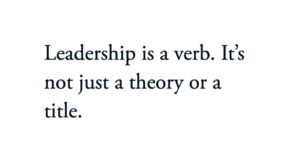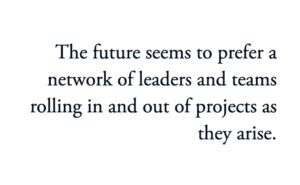
To overcome the challenges right in front of us, organizations need more effective leaders — more than ever before. Here are five principles to develop today’s leaders.
by Jason Diamond Arnold
August 31, 2020
Business is difficult in the shadow of a pandemic. You get the point. You’re aware of the challenges you face as a learning professional. But you also know that if you stop developing your talent and your leaders, your business could suffer long-term negative effects from being passive with your learning and development goals during these challenging times.
Here’s the bottom line: To overcome the challenges right in front of us, organizations need more effective leaders — more than ever before! And not just in the C-suite, but across the entire organization.
You may or may not have the ability to invest in leadership development right now, yet your organization needs effective leaders to stay competitive in this season of volatility. However, today’s leadership development programs were failing before this crisis, and now tolerating the old approach to leadership development — sitting in a classroom in an effort to learn leadership theory — is totally ineffective. And simply moving to an online learning course to learn theory isn’t any better.
Like many necessary changes caused by the events of 2020, many learning executives and professionals are being forced to move boldly and swiftly into the future of leadership and talent development.
Why have traditional leadership development programs failed? They’re failing because years of outdated practices and poor execution are exposed in the urgent need to produce real business results through our learning efforts. For far too long, most leadership development programs have been disconnected from real work, lacking any relevant context, mashed together with inconsistent curricula, and, in the end, they don’t directly impact executing on organizational strategy.
If leadership development doesn’t help the organization improve bottom-line business results … it has failed. Formally developing leaders is a waste of time without a consistent and integrated approach, ingrained into the flow of daily work and focused on actually achieving big-picture objectives of the organization.
Just like you would adjust your overall marketing or financial strategy as external forces shift market dynamics, organizations need to adjust their leadership development strategy to meet the demands of this moment in history. An overarching integrated approach to leadership development will help an organization meet the urgent business demands while simultaneously developing tomorrow’s leaders.
Consider these five factors as you adjust your approach to leadership development during these critical times.
Develop leadership by doing leadership
Leadership is a verb. It’s not just a theory or a title. Lawyers practice law. Medical doctors practice medicine. Leaders need to practice leadership, not just assume the role and title. If you’re serious about developing leaders, you need to provide them the opportunity to  practice what they’re learning through your chosen curriculum.
practice what they’re learning through your chosen curriculum.
For example, you could have leaders understand your organization’s leadership point of view and expectations, and then give your developing leaders opportunities for practical application of that theory through real work. Great leadership programs are based on a proven and effective goal-setting methodology. There’s no greater way to practice leadership than by helping others effectively pursue their objectives.
Identifying key corporate strategies is the starting point for developing your leaders in alignment with real business challenges. When seeking to develop leaders in your organization, be sure to have a relentless focus on creating and pursuing relevant team objectives and individual goals that are aligned to that strategy, especially the ones that address urgent business needs. Developing leadership skills through real goals and objectives gives learners the opportunity to apply leadership concepts to real-time situations while executing and adjusting the company’s strategy as the business evolves.
Develop leaders in context
Many leadership development programs fail today because organizations either focus on only one set of leaders, like managers or executives. Leadership development is not a one-size-fits-all proposition. Leadership happens in different contexts, throughout different situations, on a day-to-day basis. Today, there can’t be one set of leadership skills for everyone in the organization.
Leadership happens in different contexts, and at different levels of the organization. Just because one leader has earned an MBA doesn’t mean they’re equipped to meet the many unique needs of the entire organization. It also means that while many leaders may bring valuable leadership experiences to an organization, it doesn’t mean they’re done developing as a leader.
Leadership, like other professional practices, is always evolving and largely dependent on the context in which you’re practicing your skills. Leadership at an executive level has a unique set of complexities that differ from someone leading a team or an individual.
One HR leader recently argued in Harvard Business Review that leaders should stop thinking about problems being “complicated” and instead embrace them for being “complex.” Though complicated problems require linear thinking, like a long series of predictable events to be programmed, complex problems require nonlinear, situational thinking, using the power of collective intelligence and collaboration with your employees at every level. Being able to lead through these complexities starts with understanding what context you’re attempting to influence others in.
Executive leaders make decisions regarding organizational strategy and the complex needs of a larger number of people. Team leaders are often focused on the needs of a team trying to execute a precise objective, like developing a new product, service or project. Managers need to have more of a focus on the motivation and skills of their direct reports. And individual contributors should be developing their leadership mindset while influencing themselves and others during the pursuit of their individual goals.
Does your leadership development program have a foundational set of core leadership competencies while considering the various contexts of how people lead throughout the organization? If not, you may not be setting yourself up for success without considering the various contexts your leadership operates from.
Develop a common leadership language
Despite the rapidly evolving world of business and the complex contexts in which you’re leading from, having a foundational leadership language across the organization is critical to the long-term success of your leadership development program. While context is important, core leadership concepts at the executive level should not be dramatically different from a manager or team leader’s leadership practice.
Recent articles from management consultants claim that the future of organizations will be an end to management. Whether it’s “firestarter teams,” “micro-battles,” or “spiky leadership,” as Bain believes, or “agile” leaders ending “management misery,” as BCG argues, the future seems to prefer a network of leaders and teams rolling in and out of projects as they arise. This means that leaders need a core set of common practices and terms that can be easily understood no matter what context you’re trying to lead from.
That’s why a common leadership curriculum creates the foundation for a good leadership development program. Whether you adopt a transformational leadership or situational leadership approach or develop your own leadership program, having a common language that everyone understands regarding your leadership practices will set the foundation for a culture of excellent leadership.
Develop consistent leadership skills
Leaders have always needed access to a robust, so-called “soft skills” curriculum to complement their core leadership competencies. But in today’s socially conscious, employee engagement- and retention-focused culture, there is nothing “soft” about the layers of macro- and micro-skills needed to be a good leader. Today’s leader needs access to a tool box of influencing skills depending on the needs of the moment.
 In fact, many learning analysts believe we’re living in a reskilling revolution, of which soft skills are a major component. For example, after the World Economic Forum met in Davos this year, they built the Reskilling Revolution Platform. Upskilling and reskilling was also the focus in this year’s LinkedIn Workplace Learning Report. Reskilling and upskilling, even for leaders, is more than a trend — it’s an evolution of what a leader needs to be successful in today’s knowledge workforce.
In fact, many learning analysts believe we’re living in a reskilling revolution, of which soft skills are a major component. For example, after the World Economic Forum met in Davos this year, they built the Reskilling Revolution Platform. Upskilling and reskilling was also the focus in this year’s LinkedIn Workplace Learning Report. Reskilling and upskilling, even for leaders, is more than a trend — it’s an evolution of what a leader needs to be successful in today’s knowledge workforce.
When considering a micro-skills curriculum, like goal-setting, listening, problem-solving, difficult conversations, change management, trust or emotional intelligence, make sure it’s aligned with your foundational, or macro-, leadership skill sets. Some leadership development curricula may feature a listening skills course that has a disconnected or completely different approach to other leadership skills offered in the program. Each micro-skill should build upon core leadership skills within a common leadership language, serving as a library of skills to use based on the needs of the moment but still anchored to core leadership competencies of the organization. In other words, consuming a course on listening from a leadership expert should be consistent with a similar course on problem-solving or difficult conversations by the same, or a different, content provider.
Develop leadership analytics
The information age has produced an ocean of data on everything from consumer buying habits and TV binges to producing a lineup for a major league baseball coach based on who is pitching and where the game is being played on a nightly basis. “By 2025,” one writer claims, “it’s estimated that 463 exabytes of data will be created each day globally — that’s the equivalent of 212,765,957 DVDs per day!”
People analytics is a growing area of data science, especially in the fields of talent acquisition and engagement. Just as people and learning analytics have become a critical component for HR and training professionals, so too is an approach to the type of data your leaders are — and should be — producing in their daily collaboration with others. Leadership analytics should be layered with HR data related to attracting, engaging and retaining employees.
However, leadership analytics is a largely unexplored practice within organizations. Many organizations are data-driven and value “facts” over gut feelings, but those same organizations lack a robust leadership analytics strategy to shape their leadership development and evaluation efforts.
If you’re going to implement a leadership development program with a common language in the midst of complex situations, you’ll need more than just qualitative data traditionally found in engagement surveys. You’ll need a plan to capture quantitative data that actually pinpoints and charts certain leadership behaviors, primarily through performance and collaboration software your organization is already using — or should be using. If all great performance and leadership practice begins with clear goals, then there should be a focused effort to collaborate more effectively on those goals within platforms that make it easier to communicate, pivot and evaluate not just employee performance, but leadership practices in relation to that performance.
Leaders can get practical today — to stay competitive tomorrow
We have entered a brave new world of business within the ominous shadow cast by COVID-19. By following some of these practical principles for leadership development, you can build a modern learning organization that develops leaders through practicing leadership — not just learning about it. With a consistent and common framework built for any context of leadership within the organization, you can leverage and link your investment in leadership development directly to bottom-line business results.




